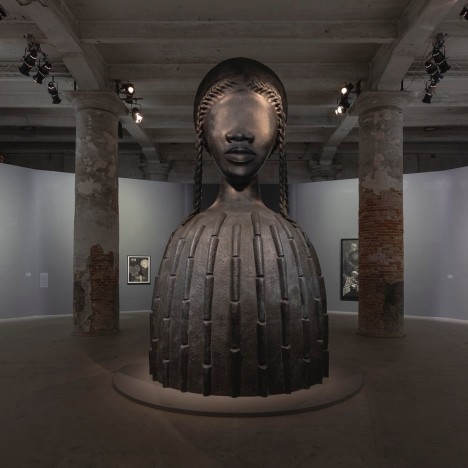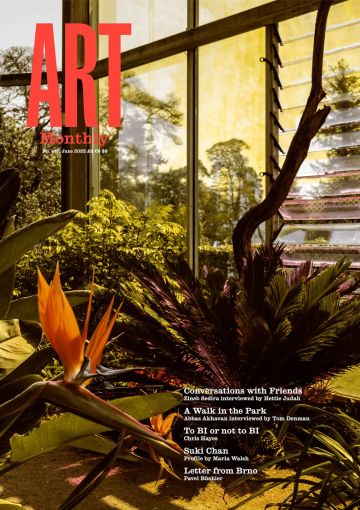Review
59th Venice Biennale: The Milk of Dreams
Chris Clarke finds a parallel timeline revealed

Simone Leigh, Brick House, 2019
The three years since the previous Venice Biennale have encouraged us to imagine other worlds. A collective fear of contamination through human interaction, the replacement of face-to-face conversations with computer screens, the prohibition on experiencing art in the flesh. Individuals might easily disappear within themselves, to prefer inner space to the stark conditions of external reality and, while it is too straightforward to say that ‘The Milk of Dreams’, curated by Cecilia Alemani, is a direct consequence of the pandemic lockdown, its liberating, fantastical effects and sense of otherworldliness are undoubtedly amplified by this contemporary context. In any case, audiences appeared starved for authenticity, voraciously teeming into venues and spewing forth first impressions almost immediately upon exit.
Simone Leigh’s bronze bust of an imperious black woman stands sentinel at the outset of the Arsenale, serving as a figurehead and a foreshadowing of what lies beyond. With braids cascading from her hairline, tied off in cowrie shells and framing an eyeless face, her inscrutable, impassive bearing suggests an inviolable distance from the demands of the congregating spectators below. Along the walls surrounding the broad circular hem of her skirt, an array of black-and-white collograph prints by Belkis Ayón reveals ambiguous beings engaged in the occult activities of the secretive Afro-Cuban Abakuá fraternity. These wide-eyed, masked and enigmatic figures infer a range of contrasting associations with Leigh’s work: concealment and disclosure, initiation and exclusion, vision and blindness. The themes run, in turn, like a leitmotif throughout the exhibition. What are we granted access to and what remains unseen, out of reach? What have we been missing and what happens when the orthodoxies of history are overturned and the accepted consensus upended?
A series of five miniature ‘time capsules’, intermittently positioned across both venues of the Biennale, provide a necessary corrective. Here, Alemani gathers objects and materials relating to different aspects of artistic production, from concrete poetry to automata and cyborgs, to posit an alternative archive, a repository of obscured and overlooked contributions to her overarching narrative. In the Central Pavilion of the Giardini, a section entitled ‘The Witch’s Cradle’ explores themes of metamorphosis and hybridity, encompassing Claude Cahun’s disarming photographs of her head trapped within a bell jar, film footage of the German expressionist dancer Mary Wigman’s convulsive choreography, and Leonora Carrington’s Portrait of the Late Mrs. Partridge, 1947, a chimerical female figure who carries – or is turning into – an oversized blue-feathered bird (Carrington’s collection of illustrated fairy tales for her son, Leche del sueño, gives ‘The Milk of Dreams’ its title). The entire room is swathed in plush golden carpet that seamlessly creeps into shimmering painted walls, an unsettlingly tactile decor that reminds one of Meret Oppenheim’s famous fur-lined cup and saucer: the artist is represented here with an equally disconcerting image of a woman’s neck transmogrifying into a cow’s hoof.
A suite of canvases by Cecilia Vicuña, painted during the period of the 1973 coup in Chile, suggests a poetic response to political turmoil, as if such events can only be articulated by allegory or mythology. In Bendigame Mamita, 1977, the artist’s mother (who saved the artwork during Vicuña’s exile in London) holds a guitar aloft so that her left eye magically overlaps with and peers through its sound hole, while an array of vignettes from her life occupy the upper third of the composition. La Comogente (The People Eater), 2019, was remade from a lost 1971 original and provides a very different vision of individual creativity. A nude giantess swallows a line of naked figures, marching inexorably into her maw, while balancing herself against a cityscape. ‘I dreamt I had to eat evil doers,’ Vicuña explains, ‘digest them, and defecate them for my shit to fertilise the land, so a new civilisation can be born.’ The instinct that compels expression can be turned into the justification of tyranny.
You hear Mire Lee’s work before you see it: Endless House: Holes and Drips, 2022, is a kinetic assemblage of ceramic entrails and motorised pumps audibly dribbling a slurry of liquidised clay. Its tendrils are slung over an armature of scaffolding, a flayed skeleton of unrecognisable limbs oozing a viscous solution, turning the body inside out. A pool of fluid drains through the concrete floor, presumably feeding back and sustaining itself. In Eglė Budvytytė’s mesmerising film Songs from the Compost: mutating bodies, imploding stars, 2020, made in collaboration with Marija Olšauskaitė and Julija Steponaitytė, a cast of androgynous adolescent performers enact crab-like movements, languidly unfurl and slide down sand dunes, and coil their bodies together with moss-covered tree trunks. Prosthetic talons protrude from their fingers and barnacles cling to their legs, and, against a reverberating auto-tuned hymn – ‘hello / I am a portal / I am a border line between stone and animal intelligence’ – their alienating otherness, of physical modification and non-binary identification, proposes a new evolutionary stage.
There is this syncretic impulse throughout the exhibition, positing an expanded, holistic worldview which melds nature and technology, science and mythology, and where the individual is merely one component amongst a wider constellation of human and non-human entities. This perspective is tangible on entering Delcy Morelos’s Earthly Paradise, 2022, a vast installation of soil blended with cloves, cinnamon, hay and flour. The scent warmly engulfs and intoxicates visitors as they pass between channels carved out of the densely packed earth; I spied several people surreptitiously lifting their face masks to inhale the aroma, a rejuvenating reminder of normality. There are a few occasions like this in the Arsenale, where Alemani hands over a broad expanse of space to a single artist, and the shift in scale and tempo provides a welcome relief from the more concentrated aggregations of paintings and objects. Kapwani Kiwanga’s Terrarium, 2022, comprises sweeping, semi-transparent painted draperies that partition the building’s wide-open thoroughfare into discrete niches while silhouetting nearby artworks in hues of sunset orange-yellow. Glass boxes, with internal curved compartments filled with fine sand, attest to this sense of containment, of the earth captured and contorted into forms (or melted into glass itself). These twin pursuits of the ecological and the fantastical are perhaps best married in the Arsenale hall’s grand finale: Precious Okoyomon’s installation of sprawling vegetation, trickling streams, stone gardens, live butterflies, and various totemic figures rendered in lamb’s wool, dirt, yarn and blood. Entitled To See the Earth before the End of the World, 2022, the dreamlike environment has a discomfiting subtext: the sugar cane stalks and invasive kudzu vines (introduced to the US by government officials in response to the over-cultivation of cotton) hark back to networks of slavery and colonialism.
If one of the legacies of Surrealism is not to take objects at face value, then ‘The Milk of Dreams’ similarly keeps its politics subtle, addressing the outside world only obliquely and indirectly. This ostensibly introspective approach belies a quietly radical agenda, as gestures towards difference and alterity are inextricably enmeshed within the exhibition’s propulsive trajectory. The narrative of an inherently female, queer and post-colonial surrealist history pulses subconsciously, thrumming underneath the official canon of melting clocks, sliced eyeballs and phallic pipes (that are not pipes). There is, instead, another history that unfolds throughout, and one that very quickly feels essential, as if this parallel timeline was always running alongside our own, repressed but patiently waiting to take over.
Chris Clarke is a critic and is senior curator at the Glucksman, Ireland.
First published in Art Monthly 457: June 2022.









